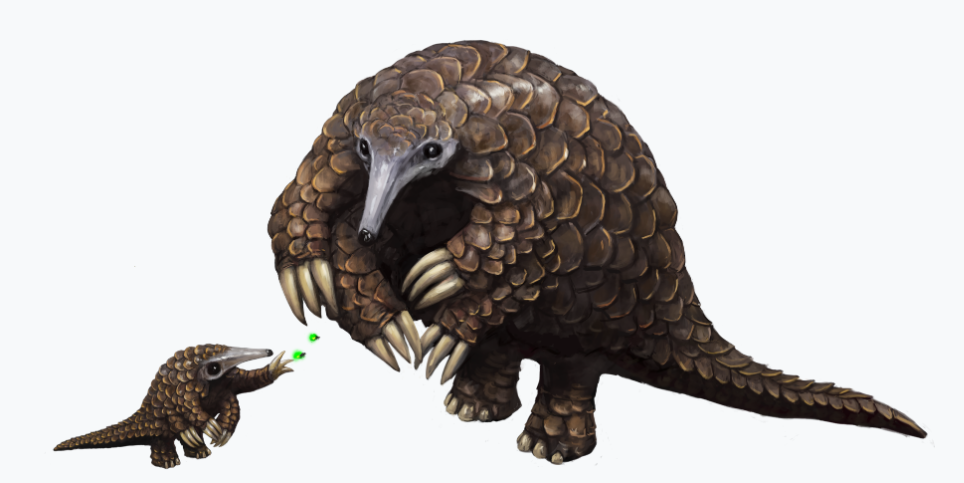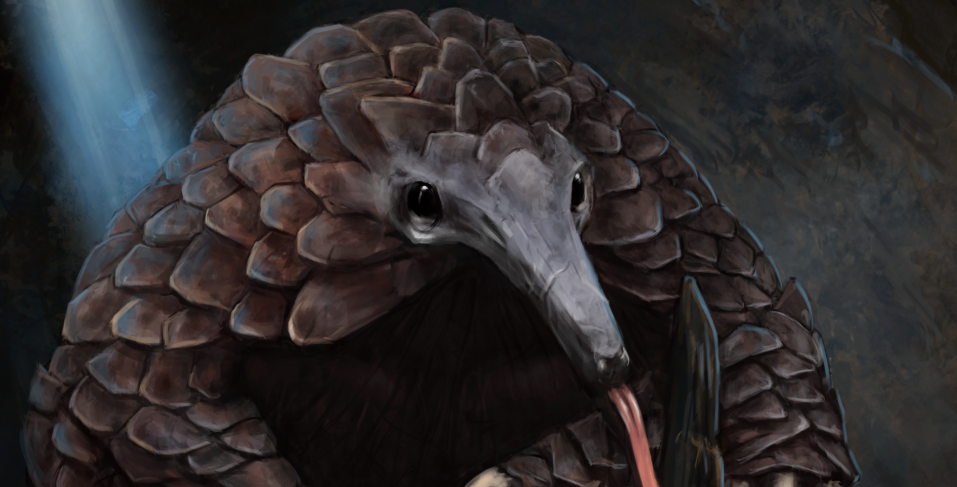Dutroti
Takes more than muscle to be built for war. You need a stomach for blood and a heart that's hungry for victory. That ain't these creatures, not at all. Big and strong they might be but blood and victory... that ain't them. Family, eating, and hiding, that's the Dutroti.
No species in Tairos better exemplifies what it means to be genuine and selfless than the Dutroti. Ambition, glory, greed, and legacy drive the actions of other creatures to build cities and forge nations but for these gentle people all that matters is family.
This simple approach to existence has doomed the Dutroti to cycles of exploitation, slavery, and pain for as long as they can remember. First, at the hands of their Architects who built the city of Sha'Hidun, then to the Drekh who harvested them for their genetic bounty, and finally the Xikhani who wish to enslave and sell them to sinister merchants all across the stars.
This has left the Dutroti scattered and in hiding. Their numbers dwindle ever closer to extinction as their value to the Drekh and Xikhani rise while resources shrink. Now, more than ever, each Dutroti life is cherished by their kind. They're forced to confront the reality that this will be the final generation and the end of all families.
Origins of the Dutroti
Little is known about Tairos and the time before Skyrir and the Dragons. The ancient writings of the old tribes of Tairos are the best source of knowledge left and even their secrets come second hand; left over fragments from a time prior to even their civilizations. They simply say that Tairos' old gods were bearers of life and beings of cosmic hunger. They created all manner of twisted life to serve their whims and devoured their children at a whim. The natural life of Tairos shrunk away from the cancerous beings birthed from the old gods. Though biased, much of this information can be confirmed in the maddening texts of the Cult of the Scorned One, the high lord of the old gods.
The first Dutroti are believed to owe their origin to one of those ancient entities, specifically a collective known as the Architects. Only that is known for certain is that they built The Gates that once dotted Tairos and it can be assumed that the Dutroti acted as their labor force. When the Old Gods left and their creations ran rampant across the land the Dutroti instead chose the safety offered by subterranean depths. It's there they migrated, evolved, and began a civilization.
The Age of Bounty
Durtroti don't measure time very accurately, it simply is not a concern for them. Seasons are less pronounced in the Bitter Depths and change is infrequent as best. No one among their people seek recognition or remembrance either. While tens of thousands of years may have come and gone on the surface; below it is barely recorded. There is the time of the Old Gods and there is the Age of Bounty and there is now.
The Age of Bounty was a time when the Dutroti families could range as far as they pleased, when lush fungal blooms were plentiful, when fresh water was in abundance, and when all were content. It was a golden age of sorts for these simple people and it showed no signs of ending.
Yet, in Tairos, no one is spared.
The Bleak Days of Now
The Dutroti alive today fear they will be the last of their kind. Now, as they call anything after the Age of Bounty, is a dim time when food is scare, rivers run dry, and terrible hunters fill the dark. Something happened, something that they were truly ignorant of but that would an apocalyptic effect on their home. The Queen's Rebuke. Magic is what fueled the growth of the fungal blooms and those blooms drew moisture from the surface and ate away at the base of lakes to bring fresh water to the Bitter Depths. The shockwave from the Autumn Queen's hateful act of revenge starved much of the fungus and in turn caused the flow of water to stymie. Life began to quickly wither in the absence of this bounty; including the Dutroti.
The once far-reaching family groups quickly collapsed and pulled back to the cavern networks least affected by the Rebuke. These caverns would unfortunately be ones bordering on Sha'Hidun's resting place. A region the Dutroti never dared visit and one that the exiled Drekh flocked to.
The Drekh succumbed to disease and the fungal spores of the Bitter Depths and they turned to the ancient secrets of their sleeping city. These secrets were locked away and required psychic keys to open. This "mind magic" was something alien to the surface world but among the Dutroti it was a vital part of their society. The Architects built simple psionic abilities into their beasts of burden that allowed for greater ease of control over them and allowed these slaves to access their masters' technology to carry out their tasks.
First, the Drekh began hunting them to access the organs needed to interface with Sha'Hidun and all its hidden caches. However, another concern would soon present it self, one that could only be answered with Dutroti blood. The Spoilage. The long-term impact the Bitter Depths had on the Drekh manifest in illness, weakness, malnutrition, and mind clouding fugues. Their environment was slowly killing them but salvation came in from Sha'Hidun and the technology left behind here. Aside from the psychic key offered by the Dutroti mind, their very essence... their genes, provided the panacea to save the Drekh people. By harvesting their organs, processing their blood, and introducing it slowly into their own bodies it would inoculate them against the ravages of the Bitter Depths.
The Drekh began hunting the Dutroti with desperate zeal, culling tens of thousands of their kind. Entire familes were captured and rendered down to their constitute elements for Drekh consumption. Every Dutroti life was destined to end as vial on a shelf waiting to be injected into the dark elf masters of the Screaming City. So quick and effecient were these harvests that only a handful of Dutroti managed to escape them and warn the others. In the race to escape families were split, parents would sacrifice themselves buy time for their children, and those who'd already lost their loved ones threw themselves at the Drekh with a fury unseen in their kind before. Sadness, desperation and crushing depression seized the survivors and the only thing pushing them forward was the duty to family and to those that gave their lives.
Today, the Dutroti species is a shadow of its former self and the trauma of the Drekh harvests still runs deep in their hearts. The families alive today are made up of the disjointed fragments of shattered families from the hunts. They are a fearful people who follow the fungal blooms and desperately seek to remain hidden from the eyes of Sha'Hidun. In the heart of the Drekh empire a Dutroti life will only ever be a means to cull wealth and prestige from the nobility.

Dutroti by Steve Bellshaw

Dutroti Mother and Pup by Steve Bellshaw
Basic Information
Genetics and Reproduction
Sexual Reproduction.
Ecology and Habitats
Prefer subterranean habitats like that of the Bitter Depths
Dietary Needs and Habits
Dutroti are foragers and prefer to graze on fungus and fungal spores. They're able to go a considerable amount of time without water and food by supplementing their diet with certain mineral-rich stones if needed. Dutroti living off mineral deposits are exceptionally sluggish even by their own demure standards.
Additional Information
Social Structure
Family is paramount to the Dutroti people. They have no gods, no nations, and no supreme rulers. Every guiding aspect of their lives is focused on family. The eldest female is generally the head of the family unit though in recent times thanks to the upheaval of the Drekh hunts that position can often fall to any determined member of the house hold.
Uses, Products & Exploitation
Dutroti have a long history of exploitation. It's unclear whether they some parent species originally and the Architects stole and rebuilt them to suite a new purpose or if they were grown from "scratch" entirely. Either way, their existence has been one of enslavement. The Architects used them for labor and the Drekh (and their Xikhani masters) treat them as cattle. Elements of their biology can be used to create an inoculation that proofs the Drekh against the toxins of the Bitter Depths (though not without side effects). The Xikhani trade them to other, wicked merchants, across the stars. And, should the Architects ever return than an existence in chains is the best they could hope for.
Geographic Origin and Distribution
In the Bitter Depths and generally as far from Sha'Hidun as they're able to reach
Average Intelligence
While their civilization would be classified as Stone-Aged they themselves are not lacking in intellectual capacity though they do often question the worth of certain intellectual pursuits that surface dwellers cherish. Things like written history, architecture, pursuits of vanity, and most sciences.
Perception and Sensory Capabilities
Excellent sense of dark vision, smell and taste. Overall situational awareness and inter-species communication are enhanced by very minor psychic capabilities
Symbiotic and Parasitic organisms
The gut of the Dutroti is generally home to an entire biome of fungal species that have evolved to survive the acids and pressures there. These fungi aid in the digestion of mineral deposits, a supplementary source of nutrition for the Dutroti.
Civilization and Culture
Naming Traditions
Dutroti names generally come in the form of very specific horn-like noises that are further accented by their minor psychic abilities. Names in a more traditional sense would only be adopted if given by a creature with a purely vocal/spoken language
Courtship Ideals
Dutroti mate for life. Finding a new mate after the loss an existing partner is one of the greatest stresses a Dutroti may suffer and many do not survive, succumbing to depression, lack of appetite and often starvation.
Average Technological Level
Prehistoric/Stone-Age
Major Language Groups and Dialects
Dutroti are unable to speak the complex vocal languages of other peoples. Their mouths and vocal organs are not built for it. Their own language is somewhat musical and more a series of honking noises punctuated by telepathic notes.
Common Customs, Traditions and Rituals
They have no complex traditions or customs but one thing that is common among all their kind is to be welcoming toward others. Others of their own species and toward new species as well. They assume the natural state of all life is beneficence and harmony, only once that notice is shattered by demonstration do they recognize something as a threat. This trusting nature has led to the loss of many families
Another common tradition relates to the burial of the dead. Deceased Dutroti are brought to a mass graveyard where stone cairns are build around them and "seeded" with fungal spores. The spores take root in the body and bloom into a new source of food for both them and the Bitter Depths. Dutroti graveyards are solemn places that their kind will march through from time to time, paying respects to those that feed the world now.
Origin/Ancestry
Genetic manipulation/creation by the Architects
Lifespan
100-130 years on average
Conservation Status
Nearing extinction
Average Height
10' to 15' feet tall
Average Weight
4900-5600 LBS


Comments